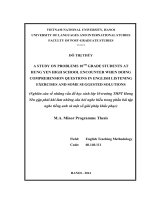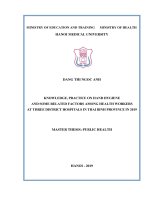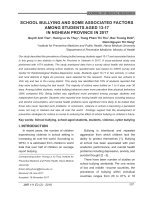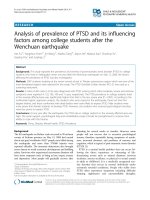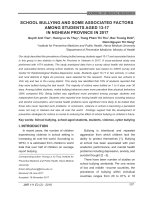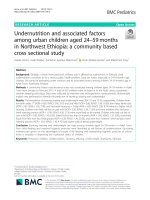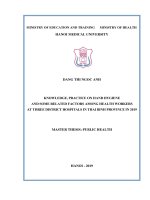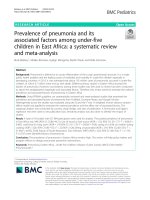Eating habits, hygiene practices, physical exercises and some associated factors among school students aged 13 17 at hai phong in 2017
Bạn đang xem bản rút gọn của tài liệu. Xem và tải ngay bản đầy đủ của tài liệu tại đây (325.14 KB, 8 trang )
JOURNAL OF MEDICAL RESEARCH
EATING HABITS, HYGIENE PRACTICES, PHYSICAL
EXERCISES AND SOME ASSOCIATED FACTORS AMONG
SCHOOL STUDENTS AGED 13-17 AT HAI PHONG IN 2017
Tran Quynh Anh1,, Bui Van Tung¹, Nguyen Thi Thanh Xuan²
¹Institute for Preventive Medicine and Public Health, Hanoi Medical University
²Department of International Collaboration & Research, Vietnam National Cancer Hospital
A cross-sectional descriptive study with a target to describe eating habits, hygiene practices, physical
exercise and some associated factors among school students aged 13-17 at Hai Phong in 2017. A sample
of 1548 students participated in the survey using self-reported questionnaires. Results show that most
students eating fruits and vegetables < 5 times/day (75.2%), and 23.4% of students drank carbonated soft
drinks ≥ 1 time/day. 43.2% of students did not usually wash hand before eating and after using the toilet
and 34.9% did not usually wash hand with soap. Most students did physical activity less than 5 days/week
(77.9%); 43.3% of students did not walk or cycle to school, and 36.4% did not play sport (during 7 days).
Risk factors that increase improper health behavior include students in the age group 16-17, educational
attainment of a parent who has not graduated from high school, being overweight/obese and not being educated
health. The intervention of school families and society is needed to improve students' health behaviors.
Keywords: GSHS, Students, Health behaviors
I. INTRODUCTION
The health-related behaviors of lifestyle
during school years have health consequences
not only in a younger age but also over the lifecourse, with important implications for public
health. A majority of life-threatening disease
around the world is associated with health risk
behaviors.¹ Particularly, many of the chronic
non-communicable diseases of the adult years
are demonstrated to arise from behaviors that
start or are reinforced in school years, including
unhealthy diets, lack of physical activity, tobacco
Corresponding author: Tran Quynh Anh,
Institute for Preventive Medicine and Public Health,
Hanoi Medical University
Email:
Received: 19/02/2021
Accepted: 08/04/2021
JMR 141 E8 (5) - 2020
smoking, or alcohol consumption.²
In 2001, the World Health Organization,
in collaboration with the US Centers for
Disease Control and Prevention designed the
collaborative surveillance project of the Global
School-based Student Health Survey (GSHS)
to measure and assess the behavioral risk
factors and protective factors among students
ranging between 13 and 17 years old at the
national level.³ As of December 2013, 94
countries have participated in the project, and
more than 450,000 students have completed
GSHS survey.⁴ In Vietnam, a report from the
2013 GSHS showed that the percentage of
underweight students was 16.4%, overweight
was 6.4%, obese was 1,2%; the proportion of
students who usually brushed their teeth less
than one time per day, never or rarely washed
61
JOURNAL OF MEDICAL RESEARCH
their hands after using the toilet, and first tried
an alcohol drink before age 14 years is 2.9%;
58.8% and 47,2%, respectively.⁵
It is undeniable that health behavior is the
critical area where health psychology can and
has made significant contributions to improving
health among the youth.⁶ Additionally, school
students' health behaviors tend to change
over time and are influenced by changes
in socioeconomic conditions, educational
intervention programs.³ The immediate and long-
Research design: This research was a
cross-sectional study.
Sample size:
term intervention for student health care needs
to be based on up-to-date evidence of students'
health status in various settings and areas.
Although several studies on health behaviors
in some provinces within Vietnam were recently
implemented, data and information on health
risk behaviors in Hai Phong remain limited.
Therefore, we did this research with objectives:
"To describe eating habits, hygiene practices,
physical exercise and some associated factors
among school students aged 13 - 17 at Hai
Phong in 2017" to provide reference data for
future intervention programs.
who adopt health behaviors
(because this
study examines various health risk behaviors,
use p = 0.5 to maximize sample size)
- d: Absolude error (use d = 0,04)
By using the formula above, the maximum
of students for the survey is 800. To be more
precise, we multiplied it with the design effect
d = 2 Therefore, the sample should be x 2 =
1200 students. We recruited 1548 students in
the survey.
Sampling selection: This study employed a
multi-stage cluster sample design: (1) At the first
stage, purposive sampling selects two schools in
the urban area and two in the rural areas. These
two schools include one secondary school and
one high school. (2) Second, in secondary
schools, grades 7, 8, and 9 were chosen, while
in high schools, we selected grades 10 and
11. (3) The last stage of sampling consisted of
randomly selecting intact classrooms from each
grade. We chose two or three classes in each
grade depending on the sizes of the classes.
Data collection techniques: The study
applied indirect interview techniques with an
anonymous questionnaire.
Research tools and measurement methods:
This study used a part of the school-based
student health survey (GSHS) questionnaire
developed by the World Health Organization.
The GSHS was first conducted in Vietnam in
II. METHODS
1. Research subjects
Participants who met the following inclusion
criteria took part in the survey: (1) was in grade
from 7 to 12 in the last school year; (2) agreeing
to take part in the study; (3) their parent’s agree
to let them answer the survey; and (4) having
able to read and respond to the questionnaire
in Vietnamese.
2. Method
Study time: The study was conducted from
October 2017 to May 2018.
Study site: The study was conducted in six
schools in three districts of Hai Phong province,
including three secondary schools and three
high schools.
62
n = Z1 - a #
2
2
p (1 - p)
d
2
- n: Sample size
- α: Level of significance, choose α = 0.05
- Z1- α/2: Level of confidence according to
the standard normal distribution (for a level of
confidence of 95%, Z = 1.96)
- p: Estimated proportion of school students
JMR 141 E8 (5) - 2020
JOURNAL OF MEDICAL RESEARCH
2013 by the Department of Preventive Medicine,
Ministry of Health, and concerned authorities
with the support of the WHO and CDC.⁷
This study focused on five key health
behaviors among school students. Thus, the
survey topics included dietary behavior, hygiene
(including teeth cleaning and handwashing),
physical activity.
Measure indicators according to WHO
guidelines⁵
Variables: The information was provided/
collected,
including
(1)
Demographic
characteristics: gender, age, father's education
level, mother's education level, number of
siblings, the birth order in the family, academic
achievement, conduct, BMI. (2) Student health
behavioral characteristics include eating habits,
hygiene practices, physical exercises.
3. Data analysis
Descriptive statistics were used to examine
characteristic data and student health behavior,
include frequency and proportion. We applied
a binary logistic regression model to determine
the factors associated with student health
behavior. The significance level was set at p <
0.05. All statistical analyses were carried out
using Stata 15.0 software.
4. Ethics
The study proposal was approved by the
General Department of Preventive Medicine,
Ministry of Health, Vietnam (Decision No96/
QD-DP April 20th, 2017). All students in the
study provided their consent before survey
was administered. Students were allowed to
withdraw from the survey at any time.
III. RESULTS
Table 1. Personal characteristics of the participants
Demographic Factors
n
%
Male
746
48.2
Female
802
51.8
13-15
782
50.5
16-17
766
49.5
Not graduated from high school
413
26.7
High school graduate or higher
1135
73.3
Not graduated from high school
398
25.7
High school graduate or higher
1150
74.3
Have no siblings
106
6.8
Have siblings
1442
93.2
No siblings/firstborn
782
50.5
Secondborn or younger
766
49.5
Excellent, Very good
808
52.2
Good
638
41.2
Fair
102
6.6
Gender
Age
Father’s education level
Mother’s education Level
Number of siblings
The birth order in the family
Academic achievement
JMR 141 E8 (5) - 2020
63
JOURNAL OF MEDICAL RESEARCH
Demographic Factors
Conduct
BMI
n
%
Very good
1344
86.8
Good
167
10.8
Fair, Weak
37
2.4
Underweight
78
5.0
Normal
1212
78.3
Overweight/Obese
258
16.7
The results in table 1 showed that there were 1548 participants, in which the proportion of men
and women was equal. Most of the parents' education levels are from high school and above. Almost
all subjects have siblings (93.2%). The ratio of overweight/obese students is 16.7%.
Table 2. Eating habits, hygiene practices, and physical exercises behavior
among participants
Behavior
n
%
Eating fruits and vegetable < 5 times/ day
1164
75,2
Drink carbonated soft drinks ≥1 time/day
362
23.4
Eating fast food > 2 times/week
114
7.4
Cleaned or brushed their teeth < 2 times/ day
253
16.3
Not usually wash hand before eating and after using the toilet
669
43.2
Not usually wash hand with soap
541
34.9
Be physically active for (≥ 60 mins/day) < 5 days/week
1206
77.9
Do not walk or cycle to school (during 7 days)
671
43.3
Do not play sport (during 7 days)
564
36.4
Eating habits
Hygiene practices
Physical exercises
Table 2 shows that the majority of study subjects ate fruits and vegetables < 5 times/day (75.2%).
A high proportion of students do not usually wash hand before eating and after using the toilet
(43.2%), not usually wash hand with soap (34.9%). Most of the study subjects physically active for (≥
60 mins/day) < 5 days/week (77.9%).
64
JMR 141 E8 (5) - 2020
JOURNAL OF MEDICAL RESEARCH
Table 3. Some factors associated with eating habits, hygiene practices, and physical
exercises behavior among participants
Eating fruits
and vegetable
< 5 times/ day
Cleaned or
brushed their teeth
< 2 times/day
Not usually
wash hand
before eating
and after using
a toilet
Be physically
active
(≥ 60 mins/day)
< 5 days/ week
OR (95% CI)
Gender (vs. Female)
Male
1.07 (0.85 – 1.35)
1.46 (1.11 – 1.92)
1.19 (0.97 – 1.46)
0.36 (0.28 – 0.46)
1.43 (1.14 – 1.81)
1.05 (0.70 – 0.81)
1.08 (0.88 – 1.32)
1.38 (1.09 – 1.75)
1.53 (1.21 – 1.92)
1.10 (0.83 – 1.45)
1.43 (1.07 – 1.91)
1.54 (1.23 – 1.94)
1.20 (0.91 - 1.59)
1.03 (0.79 – 1.35)
1.66 (1.35 – 2.04)
0.86 (0.67 – 1.10)
0.84 (0.57 – 1.25)
0.71 (0.42 – 1.19)
Age (vs. 13 – 15)
16 – 17
Mother’s education (vs. Completed High school)
Not completed
High School
1.68 (1.26 – 2.25)
1.59 (1.19 – 2.12)
Father’s education (vs. Completed High school)
Not completed
High School
1.46 (1.11 – 1.93)
Birth order (vs. Firstborn)
Middle born or
last born
1.10 (0.88 – 1.39)
Number of siblings (vs. Not have siblings)
Have siblings
1.41 (0.92 – 2.16)
0.78 (0.47 – 1.28)
Academic achievement (vs. Excellent, very good)
Good
1.27 (0.99 – 1.62)
1.12 (0.85 – 1.49)
1.40 (1.14 – 1.73)
1.07 (0.83 – 1.37)
Fair
1.01 (0.63 – 1.61)
1.43 (0.85 – 2.40)
1.32 (0.87 – 2.00)
0.89 (0.54 – 1.44)
Conduct (vs. Very good)
Good
1.15 (0.78 – 1.69)
1.35 (0.91 – 2.03)
1.49 (1.08 – 2.06)
0.76 (0.52 – 1.09)
Fair, Weak
0.43 (0.22 – 0.83)
1.02 (0.42 – 2.94)
0.93 (0.48 – 1.82)
0.56 (0.28 – 1.13)
1.33 (0.94 – 1.87)
1.11 (0.85 – 1.45)
1.72 (1.27 – 2.32)
1.33 (0.99 – 1.79)
1.47 (1.19 – 1.83)
1.55 (1.20 – 2.01)
Overweight/ Obese (BMI Classification) (vs. No)
Yes
1.62 (1.22 – 2.18)
Health education (vs. Yes)
No
1.11 (0.88 – 1.40)
The behavior of eating fruits and vegetables the risk factors that increase unhealthy behavior
include: age group 16 - 17 (OR = 1.43; 95%CI:1.14 - 1.81), mother's education not completed high
school (OR = 1.46; 95%CI: 1.68 - 2.25), father education not completed high school (OR = 1.46;
JMR 141 E8 (5) - 2020
65
JOURNAL OF MEDICAL RESEARCH
95%CI: 1.11 - 1.93), overweight/obese (OR =
1.62; 95%CI: 1.22 - 2.18), next to that protection
factors are defined as conduct fair/weak (OR =
0.43; 95%CI: 0.22 - 0.83). The behavior hygiene
risk factors that increase unhealthy behavior
include male (OR = 1.46; 95%CI: 1.11 - 1.92,
mother's education not completed high school
(OR = 1.59; 95%CI: 1.19 - 2.12), father education
not completed high school (OR = 1.43; 95%CI:
1.07 - 1.91). The behavior washes hand before
eating and after using a toilet, risk factors that
as the importance of balanced diets. The
proportion of students who drank carbonated
soft drinks one or more times a day was 23.1%.
On the other hand, the figure for fast food
consumption on three or more days during 7
days was slightly 7.4%. This rate is relatively
low compared with trends in other countries
in the same region. For example, according
to the GSHS Thailand report 2015, 56.1% of
the students reported that they had regularly
consumed carbonated soft drinks one or more
increase unhealthy behavior include mother's
education not completed high school (OR =
1.53; 95%CI: 1.21 - 1.92), father education not
completed high school (OR = 1.54; 95%CI:
1.23 - 1.94), conduct good (OR = 1.49; 95%CI:
1.08 - 2.06) and not being educated health
(OR = 1.47; 95%CI: 1.19 - 1.83). The behavior
physical exercises, risk factors that increase
unhealthy behavior include: age group 16 - 17
(OR = 1.38; 95%CI: 1.09 - 1.75), overweight/
obese (OR = 1.72; 95%CI: 1.27 - 2.32), and
not being educated health (OR = 1.55; 95%CI:
1.20 - 2.01).
times a day, and 54.7% of those who had dined
at fast-food restaurants on three or more days
during 7 days.10 One of the main reasons was
the fact that two-thirds of the sample located
in the rural area where the access or the
availability of those products are insufficient to
some extent.
Most students pay attention to oral hygiene;
our study results showed that only 16.3% of
students brush their teeth less than twice times/
day. This rate is lower than studies in other
regions in nine African countries (22.7%)11, and
Myanmar (27.6%), India (45.2%).12 However,
this result is also lower than research in other
countries in the region, such as Thailand
(12.8%), Indonesia (11.3%).12 In terms of
handwashing behavior, the study found that the
proportions reported for not usually wash hand
before eating and after using the toilet 43.2%,
washing their hands with soap 34.9%. These
findings compare somewhat with other regions,
i.e., in nine African countries, 37.8% did not
always wash their hands before eating, 41.6%
did not always wash hands after toilet or latrine
use, and 65% did not always wash hands with
soap.11 As found in previous studies, this study
also found that males were at greater risk of
sub-optimal tooth brushing than females.11,13
Contrary to some other studies, there were no
differences in tooth brushing between boys and
IV. DISCUSSION
An adequate intake of fruits and vegetables
in the daily diet reduces the risk of heart disease,
cancer, diabetes, and obesity.⁸ It is established
that unhealthy eating habits that once formed
at a younger age can lead to an intermediate
and long-term health consequence.⁹ Results
from the study show that the great majority of
school students (up to 75.2%) did not eat the
recommended five or more servings of fruits
and vegetables on a daily basis. This figure
is considerably high compared to that in other
developing countries, which, for instance, was
59% in Thailand.10 It might be due to a lack
of general awareness and knowledge among
students on their health and nutrition as well
66
JMR 141 E8 (5) - 2020
JOURNAL OF MEDICAL RESEARCH
girls, suggesting that gender differences may
not be universal and that both boys and girls
are at risk of not engaging inadequate personal
hygiene behaviors.14,15 The study results
also showed that the behavior of not usually
wash hands before eating and after using the
toilet was higher in the group without health
education.
Studies have shown that insufficient
physical activity would increase the rate of high
blood pressure, heart diseases, diabetes, and
other NCDs. As a result showed, a substantial
majority (77.9%) of students in Hai Phong
were physically active for a total of at least 60
minutes per day on less than five days during
the week preceding the survey. Besides, 43.3%
of the students did not walk or ride a bicycle
to or from school. These findings are in line
with the results of the Vietnam GSHS 2013
Factsheet, which indicated that students' level
of participation in physical activities is low, while
the level of sedentary activities is excessively
high.⁵ The proportions of physical inactivity
obtained in this study are lower than what
Aguilar-Farias et al. found in Latin America and
the Caribbean16 but higher than what was found
in Nigeria,17 Ghana.18 The possible reason for
the low level of physical activity among students
could explain the strong correlation between
sedentary behavior, on the one hand, and the
use of computers, televisions, and smartphones.
Another reason could be that some students
may not have adequate knowledge of physical
activity and the health benefits associated
with it. Regarding the association factor, the
study results showed more inactivity among
female students, 16 -17-year-olds, overweight/
obese, and without health education. Other
studies done before have also shown similar
associations factors.19,20,21
This study had several limitations. Firstly,
JMR 141 E8 (5) - 2020
data were self-reported; thus, some respondents
might have misreported either intentionally or
inadvertently on any of the questions asked.
Second, the data were collected in a crosssectional; therefore, we cannot determine
causality to any of the study's associated
factors.
V. CONCLUSION
This study has proved a large number of
school students in Hai Phong still did not pay
much attention to their health through their
performance of health behaviors. Featured as
their level of fruits and vegetable intake was
relatively low, a substantial majority of students
reported engaging in insufficient physical
activity, nearly half of our students do not usually
wash hands before eating and after using the
toilet. Risk factors that increase improper health
behavior include students in the age group 1617, educational attainment of a parent who
has not graduated from high school, being
overweight / obese and not being educated
health. The intervention of school families and
society is needed to improve students' health
behaviors.
REFERENCES
1. World Health Organization. 2008-2013
action plan for the global strategy for the
prevention and control of noncommunicable
diseases: prevent and control cardiovascular
diseases, cancers, chronic respiratory diseases
and diabetes. 2009. 9241597410.
2. World Health Organization. Health for
the world's adolescents: a second chance in
the second decade: summary. World Health
Organization; 2014.
3. World Health Organization and Centers
for Disease Control Prevention. Global schoolbased student health survey. 2013.
67
JOURNAL OF MEDICAL RESEARCH
4. Centers for Disease Control and Prevention.
Global School-based student Health Survey.
/>pdf Accessed 23 Feb, 2021.
5. World Health Organization and Centers
for Disease Control Prevention. Global Schoolbased Student Health Survey in 2013 - Vietnam
Fact Sheet. 2013.
6. Conner M, Norman P. Health behaviour:
Current issues and challenges. 2017; 32(8):
895-906.
Pacific journal of public health. 2006; 18(2): 3-11.
14. Ranasinghe S, Ramesh S, Jacobsen KH.
Hygiene and mental health among middle school
students in India and 11 other countries. Journal of
Infection and Public Health. 2016; 9(4): 429-435.
15. Rani MA, Sathiyasekaran B. Personal
hygienic practices of school going adolescentsacross cectional study in Chennai. Indian journal of
community health. 2013; 25(2): 197-199.
16. Aguilar FN, Martino FP, Carcamo OJ, et
al. A regional vision of physical activity, sedentary
7. World Health Organization. Global schoolbased student health survey (GSHS) 2013 coreexpanded questions. 2013.
8. Boeing H, Bechthold A, Bub A, et al. Critical
review: vegetables and fruit in the prevention of
chronic diseases. European journal of nutrition.
2012; 51(6): 637-663.
9. Craigie AM, Lake AA, Kelly SA, Adamson
AJ, Mathers JC. Tracking of obesity-related
behaviours from childhood to adulthood: A
systematic review. Maturitas. 2011; 70(3): 266284.
10. World Health Organization. Thailand
2015 global school-based student health survey.
World Health Organization. Country Office for
Thailand; 2018.
11. Pengpid S, Peltzer K. Hygiene
behaviour and associated factors among inschool adolescents in nine African countries.
International journal of behavioral medicine.
2011; 18(2): 150 - 159.
12. Peltzer K, Pengpid S. Oral and hand
hygiene behaviour and risk factors among in-school
adolescents in four Southeast Asian countries.
International journal of environmental research and
public health. 2014; 11(3): 2780-2792.
13. Tran D, Phongsavan P, Bauman AE, Havea
D, Galea G. Hygiene behaviour of adolescents in
the Pacific: associations with socio-demographic,
health behaviour and school environment. Asia-
behaviour and physical education in adolescents
from Latin America and the Caribbean: results from
26 countries. International journal of epidemiology.
2018; 47(3): 976-986.
17. Oyeyemi AL, Ishaku CM, Oyekola J, et al.
Patterns and Associated Factors of Physical Activity
among Adolescents in Nigeria. PloS One. 2016;
11(2):e0150142.
18. Guthold R, Stevens GA, Riley LM, Bull FC.
Global trends in insufficient physical activity among
adolescents: a pooled analysis of 298 populationbased surveys with 1·6 million participants. The
Lancet Child & adolescent health. 2020; 4(1): 23-35.
19. Tremblay MS, LeBlanc AG, Kho ME, et
al. Systematic review of sedentary behaviour and
health indicators in school-aged children and youth.
The international journal of behavioral nutrition and
physical activity. 2011; 8: 98.
20. Trang NH, Hong TK, Dibley MJ, Sibbritt
DW. Factors associated with physical inactivity in
adolescents in Ho Chi Minh City, Vietnam. Medicine
and science in sports and exercise. 2009; 41(7):
1374-1383.
21. Peltzer K, Pengpid S. Leisure Time
Physical Inactivity and Sedentary Behaviour and
Lifestyle Correlates among Students Aged 1315 in the Association of Southeast Asian Nations
Member States, 2007-2013. International journal
of environmental research and public health. 2016;
13(2): 217.
68
JMR 141 E8 (5) - 2020
